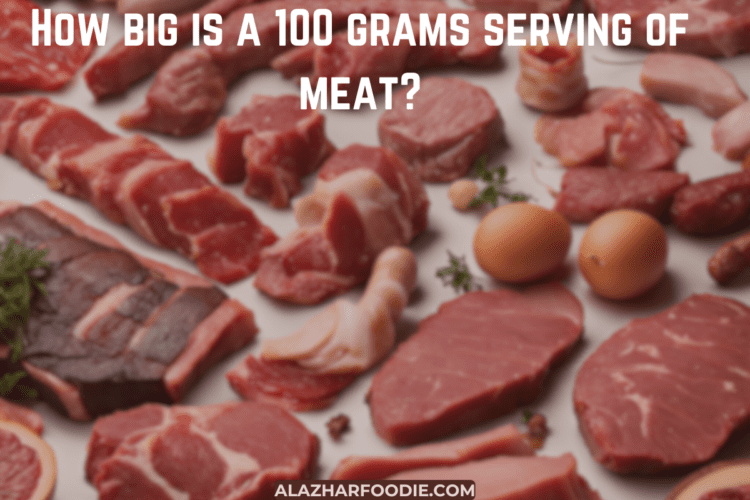How big is a 100 grams serving of meat?
How big is a 100 grams serving of meat?
Table of Contents
When it comes to portion control, many people wonder, “What does a 100-gram serving of meat actually look like?” This information is useful for monitoring macronutrients or following a particular diet.
Visualizing 100 Grams of Meat:
A 100-gram portion of steak, chicken breast, or pork chop roughly matches the size of a deck of cards or your palm. Ground meat resembles a small, compact handful or is slightly larger than a golf ball. For deli meats, 100 grams usually amounts to three to four slices, while a fish fillet is roughly the size of a checkbook.
Nutritional Information for a 100-Gram Serving:
Understanding the nutritional content of a 100-gram serving of meat can assist you in making healthier food choices. Here’s a breakdown of the nutritional values for 100 grams of different types of meat:
- Chicken Breast: A 100-gram serving of skinless, boneless chicken breast contains approximately 165 calories, 31 grams of protein, 3.6 grams of fat, and no carbohydrates. It’s an excellent lean protein source for those on low-fat diets.
- Beef: In 100 grams of cooked ground beef (85% lean), you’ll find about 250 calories, 21 grams of protein, 18 grams of fat, and no carbohydrates. Beef tends to have a higher fat content, particularly saturated fat, which is crucial to consider if you’re monitoring your cholesterol levels.
- Pork: A 100-gram portion of pork tenderloin provides around 143 calories, 26 grams of protein, 3.5 grams of fat, and no carbohydrates. Pork can be a low-fat choice, particularly with cuts such as tenderloin or loin chops.
- Fish: A 100-gram serving of salmon has roughly 206 calories, 20 grams of protein, 13 grams of fat (including beneficial omega-3 fatty acids), and no carbohydrates. Fish is an excellent choice for boosting your omega-3 intake.
- Lamb: In 100 grams of lamb chop, there are about 294 calories, 25 grams of protein, and 21 grams of fat. Lamb is higher in fat, so it’s wise to be mindful of portion sizes if you’re watching your fat intake.
Understanding How 100 Grams Fits into a Balanced Diet:
Now that you have a sense of what 100 grams of meat looks like and its nutritional value, the next step is to see how it fits into a balanced diet.
Dietary guidelines recommend that an average adult should aim for 46-56 grams of protein each day, depending on factors like age, gender, and activity level. A 100-gram serving of most meats provides about half or more of this daily protein requirement.
It’s also important to consider the fat content, especially saturated fat, as it can impact heart health. Lean meats such as chicken breast or pork tenderloin are excellent options if you’re looking to reduce fat intake, while fattier meats like lamb or certain cuts of beef should be consumed less frequently.
For those following a low-carb or ketogenic diet, meat is a great source of protein and fat without adding carbohydrates. On the other hand, if you maintain a balanced diet that includes carbohydrates, pairing meat with vegetables, whole grains, and healthy fats can result in a nutritious meal.
Do size matter?
Grasping portion sizes is crucial for sustaining a healthy diet. A standard serving of meat is around 100 grams, but it’s crucial to consider how it integrates into your entire meal.
For instance, pairing 100 grams of meat with a generous amount of vegetables and a serving of whole grains can create a balanced and satisfying meal without excessive calories.
Additionally, the cooking method you choose for meat can significantly impact its calorie content. Healthier options like grilling, baking, or broiling are preferable to frying, which tends to add extra fat and calories.
Conclusion:
A 100-gram serving of meat is a sensible portion that can easily fit into a balanced diet. Whether you prefer chicken, beef, pork, fish, or lamb, being aware of the size and nutritional content of this portion can assist you in making informed choices and achieving your dietary objectives. By visualizing portion sizes, understanding nutritional values, and opting for healthier cooking techniques, you can incorporate meat into a nutritious and enjoyable diet.
People Also Ask:
How much is 100g of meat in cups?
100 grams of meat is roughly equivalent to 0.42 to 0.5 cups for most varieties, including chicken, beef, pork, or fish.
How many slices of meat are 100 grams?
Typically, a standard portion size is around 2-4 slices, depending on the thickness of the cut.
How do you measure 100g of meat?
Water Displacement Method:
- Start by filling a measuring cup with water and marking the initial level.
- Next, add the meat to the water and observe how much the water level rises.
- For example, if the water level increases by 100 milliliters, the meat weighs approximately 100 grams, since the density of water is similar to that of many meats.
Use Known Objects for Comparison:
- You can also compare the meat to items with known weights. A standard AA battery weighs about 23 grams, so four to five batteries would be close to 100 grams.
Hand Estimation:
- The palm of your hand (excluding fingers) typically holds around 100 grams of meat, depending on your hand size.
These methods provide rough estimates and are not as accurate as using a scale.
What does a 100g of meat look like?
A serving of 100 grams of meat is about the size of a deck of playing cards or a small chicken breast.
100 grams beef protein
In terms of nutrition, 100 grams of beef contains 26 grams of protein.
100 grams of meat calories
100 grams of meat has around 143 calories.
100g cooked beef protein
For cooked beef, 100 grams also provides 26 grams of protein.
100g of Steak protein
100 grams of steak contains about 25 grams of protein.
Referred By Vocal Media Article Written By Mustafa Rangoonwala.
Recommended Articles:
What is the weirdest sounding food combination that is actually good?
What if you eat moringa powder every day?
How does flaxseed support weight management and help in weight loss?



